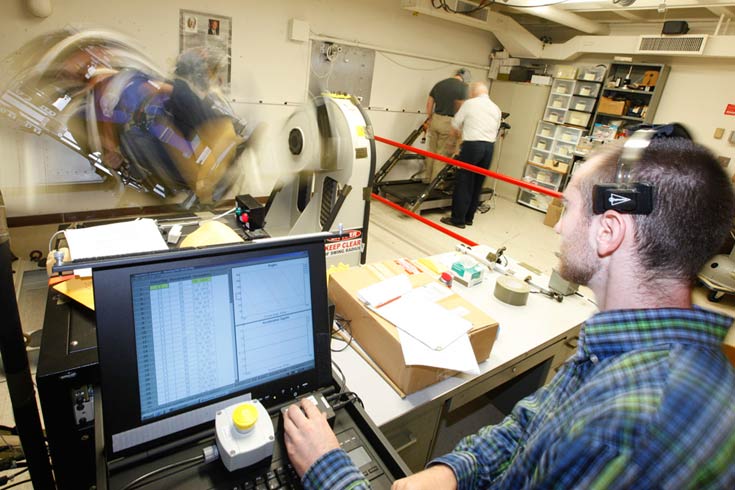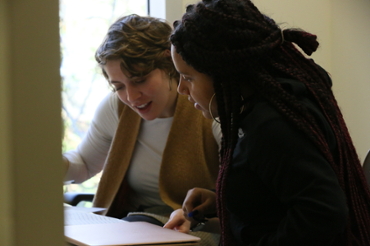Paul DiZio Researches Psychology of Movement
 January 24, 2017
January 24, 2017
By Lawrence Goodman | Brandeis Magazine
Imagine you’re a fighter pilot being chased by a heat-seeking missile. Going 1,500 mph, you undertake evasive maneuvers, climbing and nose-diving, performing barrel rolls and loops, sharply banking left and right.
Without the proper training — even with it — you’d probably feel nauseated. You’d grow disoriented, unable to tell whether you were headed up, down, left or right. You wouldn’t know how to right your jet or steer it back on course.
To find out what this experience might be like — and not die — you could take a ride on the Multi-Axes Rotation and Tilt Device (MART) on campus. A massive motorized chair, the MART rotates along the same axes as an airplane, though more slowly. For researchers at the Ashton Graybiel Spatial Orientation Laboratory, the chair stands in for the experience of being inside a cockpit.
“How do you know what’s up and down? How do you know when you’re moving? How do you know what direction you’re moving in? That’s what we’re studying,” says associate professor of psychology Paul DiZio, PhD’87, who co-directs the Graybiel Lab with James Lackner, the Meshulam and Judith Riklis Professor of Physiology.
The U.S. Air Force funds MART research to understand how pilots respond to shifts in direction and gravity. NASA uses MART research to study what astronauts experience during spaceflight. MART findings could even one day be used to develop treatments for vestibular diseases, disorders of the inner ear that affect balance.
Test subjects are strapped into the MART with a five-point harness, then are blindfolded and fitted with soundproof headphones. There’s a joystick on the right arm, an emergency-stop button on the left. The chair can lean from side to side, tilt back and forth, and twist, moving 360 degrees (though most experiments require it to move no more than 60 degrees) in any of these directions.
The chair can also move in two directions at once. If you’re sitting in it when this happens, you feel as if you are wobbling. Using the joystick, you try to find the point where the chair is once again balanced, as if you’re an egg searching for the spot where you won’t tip over.
“Even the people who get motion sick want to come back, because it’s so fun,” DiZio says.
About a decade ago, DiZio and Lackner had the idea of bolting the MART to the floor of a stripped-down DC-9 airplane, strapping in a passenger, and taking off. The plane would fly along a parabolic path, rising to 35,000 feet before arcing down and free-falling for 10,000 feet. Along the way, the chair periodically rotated to a new position. Every test subject went through 40 parabolas before the plane landed. Although participants were trained extensively beforehand, at least half still lost their lunch.
During the ride, the passengers were given a pencil-sized measuring device. As they rotated, they were asked to identify the direction an object placed on top of the stick would fall and then point the stick in that direction. They were also asked to align the device parallel to the midline of their body. This determined whether, despite the twisting and turning, they still knew which way was up and out from their body.
Not surprisingly, a lot of passengers got their responses very wrong. But it was when they got them wrong that was most revealing.
The chair rotates along three axes — pitch, roll and yaw. Roll tilts you leftward or rightward. Pitch throws you forward or backward. Yaw goes around the vertical axis that runs from your head to your feet (think of gyro meat turning on a rotisserie). When passengers on the DC-9 MART experienced changes in roll or pitch, they became substantially disoriented. Yet changes in yaw barely registered.
This finding helped confirm a radical new theory of how humans determine spatial orientation: Our bodies have an instinctual sense of pitch and roll, but we determine yaw indirectly, calculating it from the ratio of pitch to roll.
In other words, if you were a two-dimensional cutout moving around on a piece of graph paper, you would be able to accurately ascertain how far you traveled vertically or horizontally, but not along a diagonal. To know the diagonal, you would have to compute it from the other two measurements.
Though we experience ourselves moving through space in three dimensions, we are actually attuned to only two of them. Our experience of rotating around the yaw axis is a mathematical calculation our brains instinctively make so that we feel at home in three dimensions.
“This raises deep questions about perception and the human mind,” says DiZio. “When do we know we’re having a true perception of the real world, and when is it an illusion?”
He adds, “It’s the story of psychology. We overestimate how much we know and how rational we really are.”






